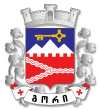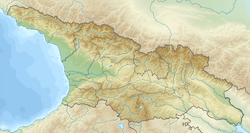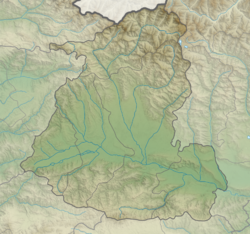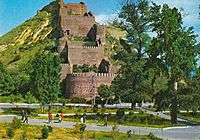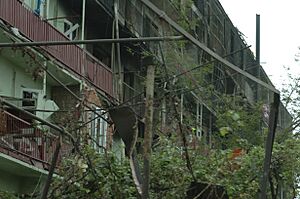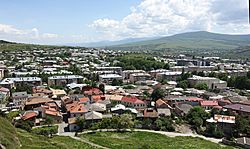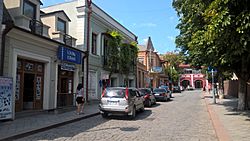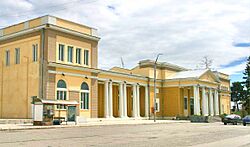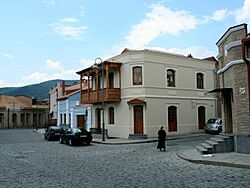Gori, Georgia facts for kids
Quick facts for kids
Gori
გორი
|
|||
|---|---|---|---|
|
City
|
|||
|
From top: Town Hall, Gori Fortress, Gori Cathedral, FC Dila Stadium, Panoramic view to Gori
|
|||
|
|||
| Country | |||
| Region | Shida Kartli | ||
| Municipality | Gori | ||
| Area | |||
| • Total | 16.85 km2 (6.51 sq mi) | ||
| Elevation | 588 m (1,929 ft) | ||
| Population
(January 1, 2024)
|
|||
| • Total | 42,596 | ||
| • Density | 2,528.0/km2 (6,547.4/sq mi) | ||
| Time zone | UTC+4 (Georgian Time) | ||
| Postal code |
1400
|
||
| Climate | Cfb | ||
Gori (Georgian: გორი) is a city in eastern Georgia. It is the capital city of the Shida Kartli region. Gori is located where two rivers, the Mtkvari and the Liakhvi, meet. It is the fifth largest city in Georgia by population. The name Gori comes from the Georgian word gora, which means "heap," "hill," or "mountain."
People have lived in this area since ancient times. The Gori Fortress was built here at least by the 7th century. Gori became a town in the 12th century. It was an important military base during the Middle Ages. The city is still important today because it sits on the main highway connecting eastern and western Georgia. Throughout its history, Gori has been invaded many times by different armies. In 2008, Russian troops occupied the city during the Russo–Georgian War.
Gori is also famous as the birthplace of several important people. These include Joseph Stalin, a well-known Soviet politician, Aleksandr Nadiradze, a designer of ballistic missiles, and Merab Mamardashvili, a philosopher.
Contents
Geography and Climate in Gori
Gori is about 86 kilometers (53 miles) west of Tbilisi, which is Georgia's capital city. It is located where the Mtkvari and Greater Liakhvi rivers meet. The city is about 588 meters (1,929 feet) above sea level.
The climate in Gori is mostly humid subtropical. This means it has warm and somewhat humid weather. Summers are usually hot. The average temperature for the whole year is 11.2°C (52.2°F). January is the coldest month, with an average of -0.4°C (31.3°F). July and August are the hottest, averaging 22.1°C (71.8°F).
Gori gets about 507 millimeters (20 inches) of rain each year. May is the wettest month, with about 65.8 millimeters (2.6 inches) of rain. February is the driest, with about 28.2 millimeters (1.1 inches). The highest temperature ever recorded was 38.0°C (100.4°F) in August 2006. The lowest was -22.2°C (-8.0°F) in December 2004.
| Climate data for Gori (1991–2020 normals, extremes 1981-2020) | |||||||||||||
|---|---|---|---|---|---|---|---|---|---|---|---|---|---|
| Month | Jan | Feb | Mar | Apr | May | Jun | Jul | Aug | Sep | Oct | Nov | Dec | Year |
| Record high °C (°F) | 15.6 (60.1) |
20.5 (68.9) |
26.0 (78.8) |
30.5 (86.9) |
32.0 (89.6) |
36.8 (98.2) |
37.4 (99.3) |
38.0 (100.4) |
36.6 (97.9) |
30.9 (87.6) |
25.0 (77.0) |
20.0 (68.0) |
38.0 (100.4) |
| Mean daily maximum °C (°F) | 5.4 (41.7) |
7.1 (44.8) |
12.2 (54.0) |
17.5 (63.5) |
22.2 (72.0) |
26.3 (79.3) |
29.1 (84.4) |
29.7 (85.5) |
25.0 (77.0) |
19.1 (66.4) |
11.8 (53.2) |
6.5 (43.7) |
17.7 (63.9) |
| Mean daily minimum °C (°F) | −3.3 (26.1) |
−2.7 (27.1) |
1.0 (33.8) |
5.1 (41.2) |
9.9 (49.8) |
14.0 (57.2) |
17.2 (63.0) |
17.0 (62.6) |
12.8 (55.0) |
7.4 (45.3) |
1.4 (34.5) |
−2.2 (28.0) |
6.5 (43.7) |
| Record low °C (°F) | −19.6 (−3.3) |
−19.9 (−3.8) |
−15.1 (4.8) |
−10.5 (13.1) |
−1.0 (30.2) |
2.8 (37.0) |
7.7 (45.9) |
6.1 (43.0) |
−0.2 (31.6) |
−4.8 (23.4) |
−11.5 (11.3) |
−22.2 (−8.0) |
−22.2 (−8.0) |
| Average precipitation mm (inches) | 29.0 (1.14) |
28.2 (1.11) |
35.7 (1.41) |
53.1 (2.09) |
65.8 (2.59) |
58.7 (2.31) |
41.3 (1.63) |
36.6 (1.44) |
35.2 (1.39) |
41.9 (1.65) |
47.4 (1.87) |
33.7 (1.33) |
506.6 (19.94) |
| Average precipitation days (≥ 1.0 mm) | 6.4 | 6 | 6.8 | 8.3 | 10.1 | 8.5 | 5.6 | 5.1 | 5.3 | 6.8 | 6.8 | 6.6 | 82.3 |
| Source: NCEI | |||||||||||||
History of Gori

The area where Gori is located has been settled since the early Bronze Age. Old Georgian stories say that King David IV (who ruled from 1089 to 1125) founded Gori. He settled people from Armenia there. However, the Gori Fortress was likely used even earlier, around the 7th century. Also, archaeological finds show that a town existed here in Classical Antiquity.
In 1299, Gori was taken over by Alan tribes. They were running away from the Mongol invasion of their homeland. The Georgian king George V took the town back in 1320. He pushed the Alans back across the Caucasus mountains.
After the medieval Georgian kingdom fell apart, Gori became a target for invaders. This was because it was located at an important crossroads for trade and travel. It was captured and looted many times. First, Uzun Hassan of the Ak Koyunlu took it in 1477. Then, Tahmasp I of Persia captured it in the mid-1500s.
Later, Gori was briefly controlled by the Ottomans from 1578 to 1590. It was their main base in Georgia. But the Georgians, led by Simon I of Kartli, fought hard and took it back in 1599. The Persians, under Shah Abbas I, took control again in 1614. After being occupied by the Ottomans (1723–1735) and Persians (1735–1740s), Gori returned to Georgian rule. Kings Teimuraz II and Erekle II helped the town's economy and culture grow.
When the Russian Empire took over Georgia, Gori became a town in the Gori Uyezd of the Tiflis Governorate in 1801. It grew in size and population during the 1800s. A map from 1824 shows the town on the hills below the fortress, with a moat around it. The city was badly damaged in an earthquake in 1920. It was almost completely rebuilt during the Soviet period. Gori was an important industrial city during Soviet times. However, it faced economic problems and lost many people in the 1990s after the Soviet Union ended.
Gori and the 2008 Conflict
Gori is located near the Georgian–Ossetian conflict zone. It used to be connected to South Ossetia's capital, Tskhinvali, by a railway. However, this railway has not been used since the early 1990s. Since the 2000s, Georgia has built up its military facilities in and around Gori. For example, the main military hospital was moved from Tbilisi to Gori and updated in 2006. In 2008, Georgia's second NATO-standard military base was opened in Gori. This base houses the 1st Infantry Brigade of the Georgian Ground Forces.
During the 2008 Russo-Georgian War, Gori was attacked by the Russian Air Force. Both military targets and homes were hit by airstrikes. This caused injuries and deaths among civilians. Human Rights Watch (HRW) reported that Russian forces used cluster bombs in civilian areas around Gori. They claimed that on August 12, cluster bombs dropped in the city center killed 11 civilians and injured many more. Russian military officials denied using cluster bombs. Many unexploded "bomblets" were found by local people and HRW staff.
By August 11, most Georgian soldiers, government officials, and residents had left Gori. The city was then captured and occupied by the Russian military and South Ossetian separatist militia. HRW accused the militia of stealing, burning buildings, kidnapping, and attacking the people who remained. The Russian and South Ossetian forces left Gori on August 22, 2008. The next day, units of the Georgian Army returned to the city. However, Russian checkpoints stayed near Gori and in areas close to the borders with Abkhazia and South Ossetia.
Population of Gori
The population of Gori has changed over the years. Here is a table showing the population at different times:
| Year | 1865 | 1897 | 1914 | 1916 | 1977 | 1989 | 2002 | 2014 | 2022 | 2023 |
|---|---|---|---|---|---|---|---|---|---|---|
| Population | 5,100 | 10,269 | 25,355 | 18,454 | 54,100 | 68,924 | 49,522 | 48,143 | 44,524 | 44,387 |
Important Landmarks in Gori
Gori and the areas around it have many interesting cultural and historical places. While many people know Gori as the birthplace of Joseph Stalin, Georgians often remember the city for its ancient fortress.
- Gori Fortress: This old fortress is built on a rocky hill. It looks over the main part of the modern city. It's a very important historical site.
- St. George's Church of Gorijvari: This church from the 18th century is on another hill. It is a popular place for people to visit for religious reasons.
- Uplistsikhe: Not far from Gori, you can find the famous ancient rock-hewn town of Uplistsikhe. It's a city carved right into the rocks!
- Ateni Sioni Church: This church from the 7th century is also close to Gori.
Gori is also known for its connection to Joseph Stalin.
- Joseph Stalin Museum: This museum is in downtown Gori and tells the story of Stalin's life.
- Stalin Monument: Until 2010, there was a large statue of Stalin in front of the Gori City Hall. It was one of the few such statues left after Nikita Khrushchev's efforts to remove symbols of Stalin. The statue was removed in 2010, but the city assembly voted in 2012 to put it back up.
Other notable sights include:
- Gori Cathedral of Saint Mary
- Gori State Historical-Ethnographic Museum
- House of Amilakhvris
- Monument to Nikoloz Baratashvili
- Monument to Iakob Gogebashvili
- Gori Pedagogical Institute
- Gori State Drama Theater
- Gorijvari
- Erekle Baths
- Monument to Giorgi Eristavi
- Monument to Nico Lomouri
- Military city
- Theological School
Famous People from Gori
Gori is the hometown of many notable individuals. Here are some of them:
- Anastasia Eristavi-Khoshtaria (1868-1951), a famous novelist.
- Joseph Stalin (1878–1953), a key leader of the Soviet Union.
- Simon Arshaki Ter-Petrosian (1882–1922), a revolutionary.
- Vano Muradeli (1908–1970), a well-known composer.
- Aleksandre Machavariani (1913–1995), another talented composer.
- Aleksandr Nadiradze (1914–1987), an inventor known for ballistic missile design.
- Edvard Mirzoyan (1921–2012), a composer.
- Sulkhan Tsintsadze (1925–1991), a composer.
- Merab Mamardashvili (1930–1990), a respected philosopher.
- Giorgi Tenadze (born 1962), a wrestler.
- Vazha Tarkhnishvili (born 1971), a footballer.
- Georgi Kandelaki (born 1974), a boxer.
- Lasha Shavdatuashvili (born 1992), a judoka.
- Geno Petriashvili (born 1994), a wrestler.
- Oto Nemsadze (born 1989), a singer.
- Vladimer Khinchegashvili (born 1991), a wrestler who won Olympic and World Championships.
Images for kids
See also
 In Spanish: Gori para niños
In Spanish: Gori para niños








